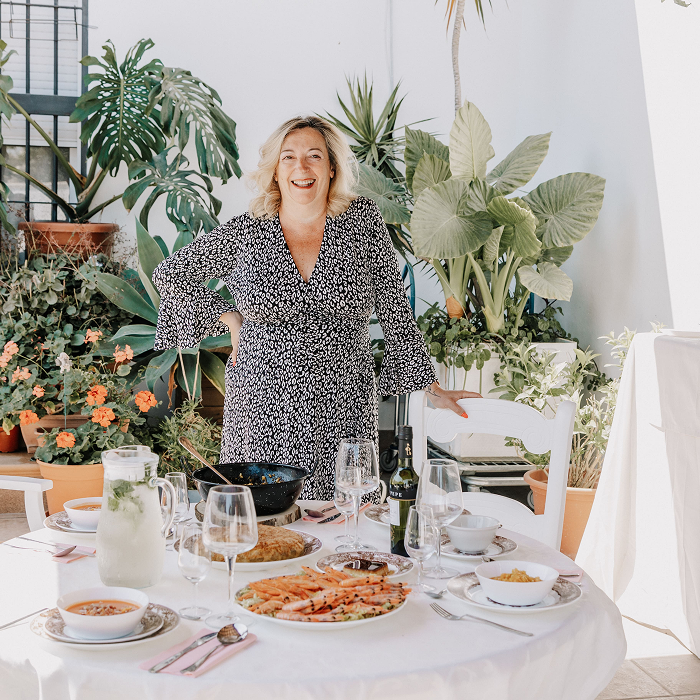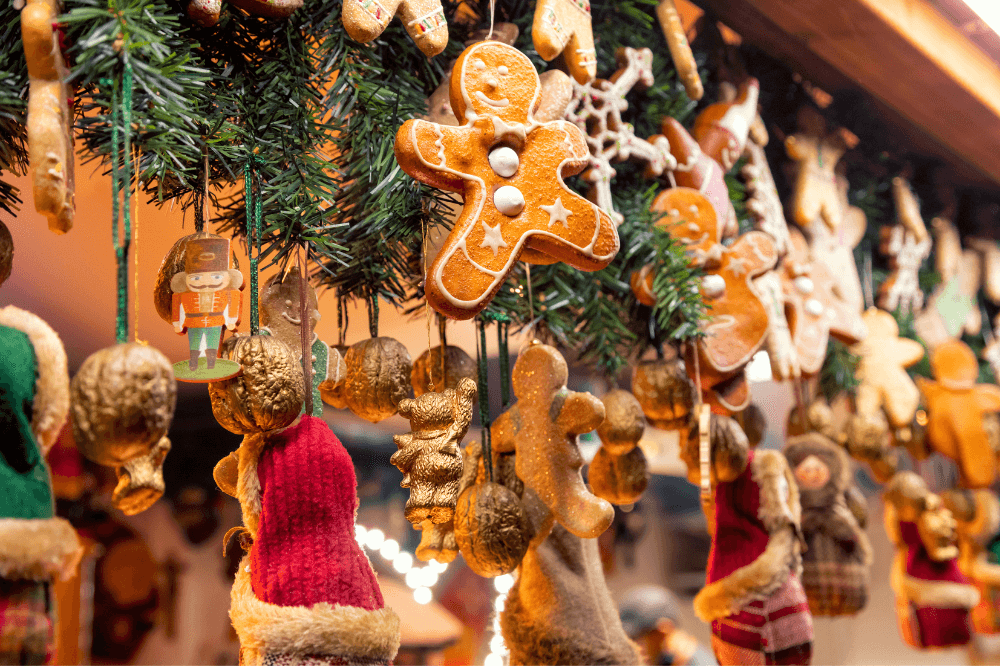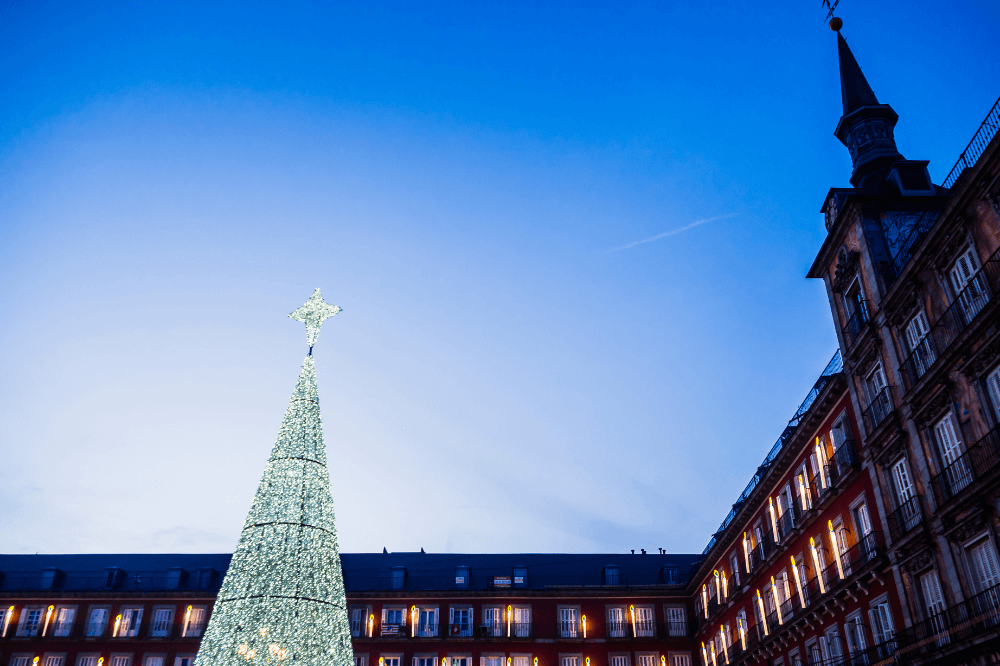It’s very likely that while searching for information about November 1st in Spain, you’ve come across two seemingly incompatible realities: on one hand, images of cemeteries filled with flowers and a reflective atmosphere, and on the other, nightclub posters promoting Halloween costume parties.
This mix raises a key question: how can I experience the “true” tradition without ending up in a purely touristy event?
Our goal is to help you navigate this duality, showing you where the heart of the celebration lies, how to plan your stay so that you’re not affected by holiday closures, and how to enjoy the food that truly brings Spaniards together at this time of year.
What is All Saints’ Day?
This day here in Spain is a very important one, although it’s true that for a foreigner it can be a bit confusing.
The essential thing you need to know is that we dedicate it to remembering and honoring our departed, it’s celebrated on November 1st and it’s a national holiday.
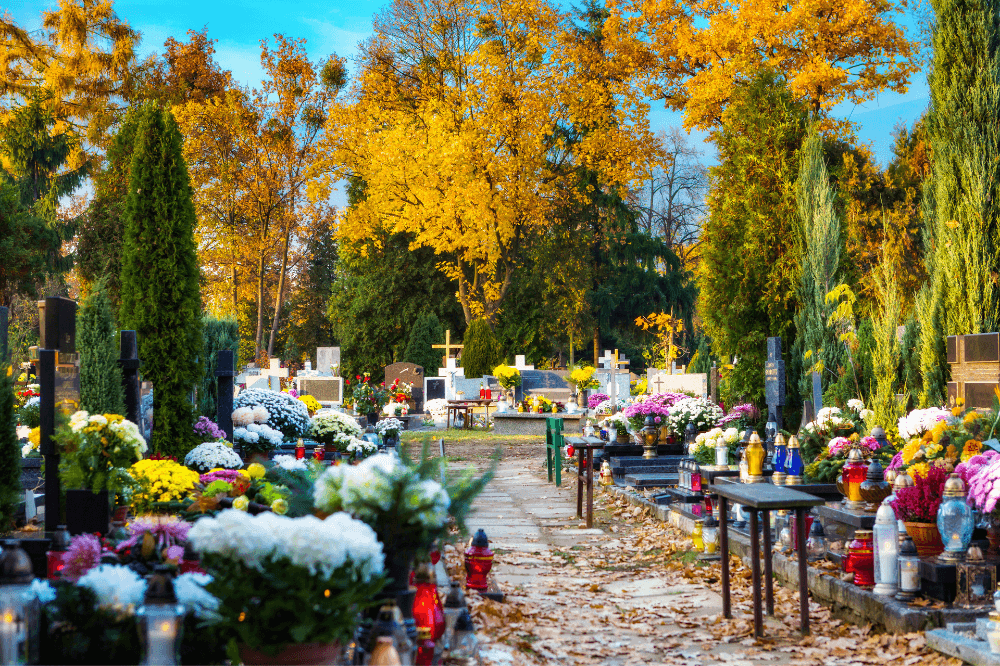
And the most widespread tradition, and the one you’ll see everywhere, is going to the cemetery.
It’s a day when families gather and visit the graves of their loved ones to clean them and, most of all, to decorate them with lots of fresh flowers.
And although it’s a day with a tone of remembrance and solemnity, it also has a side of family gathering and culinary tradition.
We usually eat seasonal sweets that vary slightly depending on the region, but the most well-known nationwide are Huesos de Santo (delicious marzipan, sometimes filled with egg yolk) and Buñuelos de Viento (fried dough, often filled with cream or whipped cream).
In other words, it’s not a noisy or spectacular celebration, but a day of memory and family unity.
People take the time to stop, remember those who are no longer with us, and keep their memory alive through a simple gesture like bringing flowers to the cemetery and gathering with family.
It’s a quiet day, but one that holds a lot of meaning for us.
Join us for a truly local experience: dine in a Spanish mom’s home.
Does Spain celebrate Halloween?
Yes, even though it’s a celebration that doesn’t have deep roots in Spain like All Saints’ Day does, it has become increasingly popular, especially over the past two decades, mainly influenced by American culture and movies.
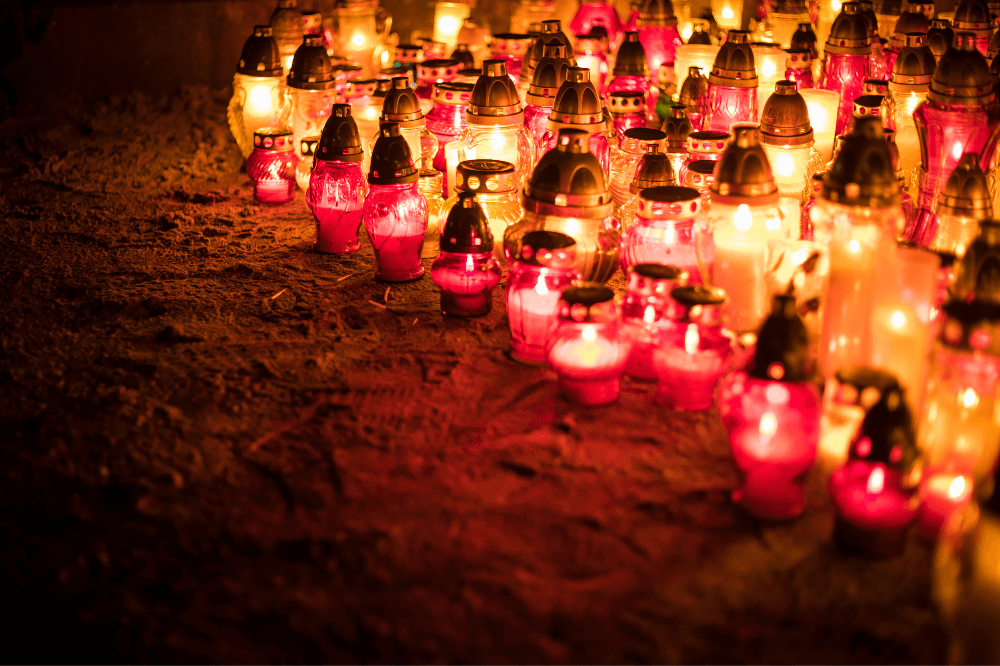
We could say that if All Saints’ Day (November 1st) is the solemn and traditional part, Halloween (the night of October 31st) is the more… let’s say imported and playful side.
In fact, the celebration is divided into two main groups.
Nightlife and adult entertainment
This is where you’ll notice Halloween the most, because bars, nightclubs, and pubs organize themed parties on the night of October 31st.
People dress up, mainly in scary costumes (zombies, vampires, skeletons), and the idea is to go out, dance, and have fun.
You’ll see a lot of pumpkin decorations, spider webs, and spooky settings in these places.
Children and families
This is the more recent part.
It’s increasingly common for children to dress up and do the famous “trick or treat” (we call it the same, or sometimes just say ‘Halloween’) around residential areas or local shops.
Not as widespread as in the United States, but it’s quite visible.
It’s also a time when many schools or shopping centers organize themed activities for kids.
Theme parks and haunted attractions
Many large parks in Spain create impressive Halloween experiences (haunted houses, special escape rooms) that last several weeks and attract a lot of people.
The duality with our own traditions
Here’s where it gets interesting: Halloween coexists with our pre-existing local traditions.
That is to say, while the commercial and costume-filled part of Halloween has taken hold, especially in cities and among young people, the night of October 31st in Spain is still a mix.
Some people go out partying, some dress up with their kids, and others prefer a more traditional family gathering with roasted chestnuts.
That said, even though the festivities have overlapped, the traditional part, remembering the departed on November 1st, remains the serious core of the date.
Typical All Saints’ Day Gastronomy
This time of year has a very specific flavor in Spain, tied to autumn produce and sweets with a long-standing tradition.
It’s not just about what we eat, each sweet has a story and is often associated with a particular region, although you can find them throughout the country.
Get up close to each tradition — in a local’s home.
Panellets (a specialty from Catalonia and the Balearic Islands)
Panellets are small marzipan-based pastries (a dough made from ground almonds and sugar).
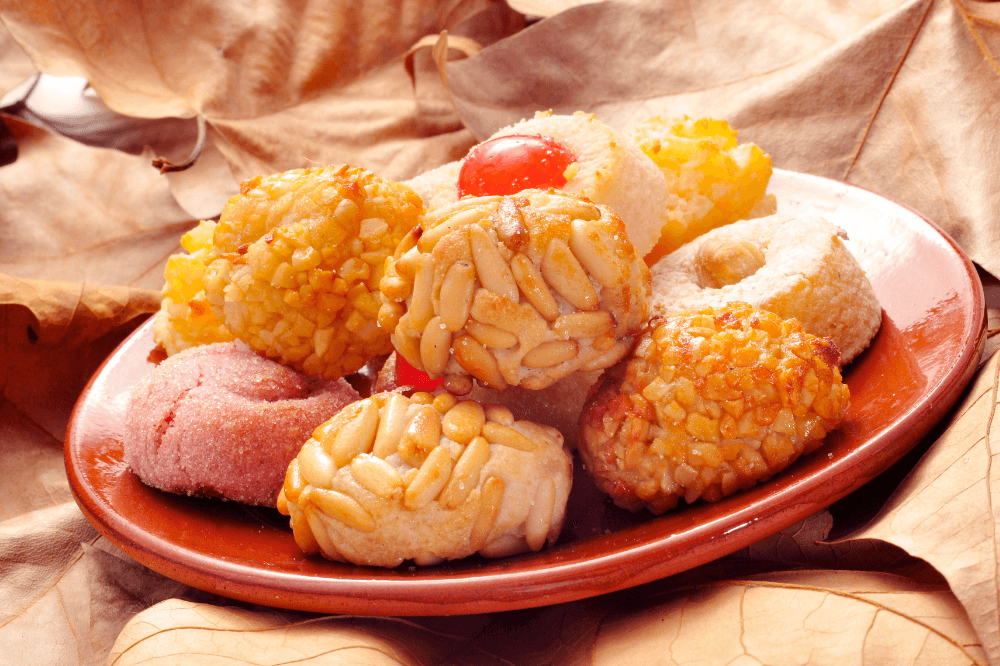
They’re shaped into little balls and covered with different ingredients to create various flavors:
- The classic coated with pine nuts.
- Other varieties with coconut, sliced almonds, chocolate, or coffee.
They’re usually eaten as part of the “Castanyada” (the traditional Catalan celebration), accompanied by roasted chestnuts and sometimes a small glass of sweet wine or moscatel.
Huesos de Santo
These are the most iconic sweets in central Spain, especially in Madrid, Castile and León, and Castile-La Mancha.

They’re small white or ivory-colored marzipan cylinders filled with a very sweet cream called yema, made from egg yolk and sugar.
They’re called “Saints’ Bones” because their shape resembles human bones, and the yema filling represents the marrow, a slightly macabre but very fitting image for the date.
Buñuelos de Viento
These are small portions of very light dough fried in oil.
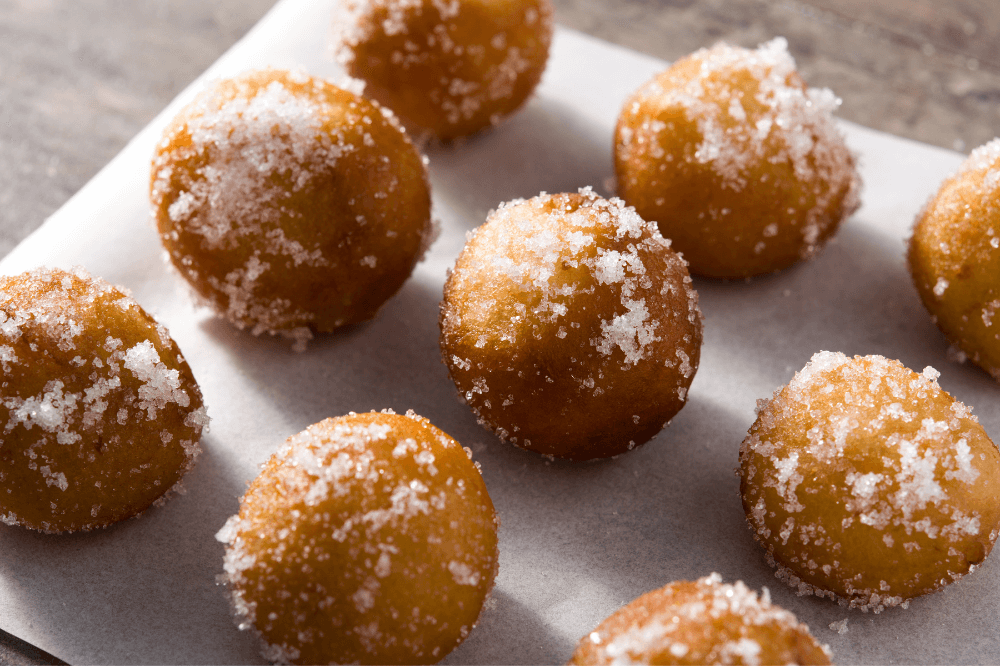
When fried, they puff up a lot (hence “de viento” or “wind-blown,” as they seem full of air) and are traditionally filled with pastry cream or whipped cream, though you’ll also find chocolate versions.
According to an old widespread belief, each buñuelo you eat helps to free a soul from Purgatory.
Tips for Visiting Spain on November 1st
All Saints’ is a very active time in Spain, which involves some specific travel logistics.
Planning is essential
November 1st is a national holiday, and if it falls on a day that creates a long weekend, many people take the opportunity to travel, either to return to their hometowns or go on a short getaway.
That’s why it’s highly recommended to book both accommodation and transport (train, bus, or rental car) as far in advance as possible.
During this time, demand skyrockets, causing price increases and a lack of last-minute availability.
Schedules and services
Keep in mind that November 1st is an official public holiday. This means that most large stores, supermarkets, and offices will be closed.
However, the hospitality sector (bars, restaurants, and cafés) usually operates as normal or even with extended hours due to the high foot traffic.
If you plan to visit museums or tourist attractions, check their schedules in advance, as some may adjust them for the holiday.
Experiencing the tradition
If you’re planning to visit a cemetery to observe the tradition, it’s best to go early in the morning or late in the afternoon on the 1st.
You’ll avoid the peak hours of heavy attendance. It’s important to remember that these are places of deep family reflection, so quiet and respectful behavior is expected.
Packing
Late October and early November mark the start of colder weather.
That means while you might enjoy pleasant sunshine at midday, mornings and evenings are cool, especially inland.
The most practical approach is to dress in layers: bring a warm jacket or a good light waterproof coat, so you can take it off easily if the temperature rises during the day.
Savor This Special Day with Sazón The Folk Cook
At Sazón, we believe that Spain’s legacy is tasted on the plate, prepared with the same care our grandmothers once cooked with.
Now, we offer you something that goes beyond a restaurant: we invite you into the heart of a home.
If you’re looking for an unparalleled cultural immersion, if you want your memory of Spain to taste real, don’t hesitate any longer.
The most authentic cuisine is waiting to tell you our story.
Book your Sazón experience today and taste our legacy!


